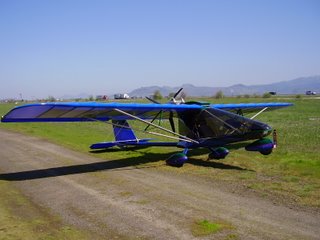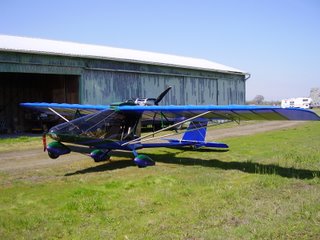Final Post
Well I was originally planning to continue making posts to share the results of my flight tests but I've come to the conclusion that I'm just too lazy. I'm having a hard time motivating myself to update this blog when I could be out flying! It's just too time consuming to update my own testing documents and then update this website. Unfortunately, the Blogger website does not allow any files to be uploaded except images. I tried using a third party file hosting site in my last post but that only worked for a short period of time before the file was deleted. I also tried importing the files into Google Documents but there were too many headaches and bugs.
If you are really interested in my performance and testing data, send me an email and I'll email you my documents.
So far I have flown my S-14 eleven times. The last ten times were done ten days in a row! I still have a lot of testing to perform but so far the plane, engine, and instruments are working great.
I will continue to update this blog with back dated posts and photos. I've made a promise to myself that I won't start any other projects until the blog is complete.
It took me 500 hours to build my S-14 and another 1000 hours doing research. All of this within two years. Building my S-14 is probably my greatest accomplishment to date. I wouldn't say I enjoyed every minute of it but it was definitely a rewarding project.
What will I build next...
Sunday, June 10, 2007
Sunday, May 13, 2007
First Flight Test Results
First Flight Test Results
Instead of rewriting the results of my flight test, I have uploaded my flight test plan which is written in MS-Word. I added the results of the flight and post inspection items to the document.
The link below will allow you to download the document. The file is hosted by a third party website which requires you to read their ads for 55 seconds prior to downloading the file. On the bottom right of the web page you will see the countdown timer.
First Flight Test Plan
Below are some photos of the squaks.



Instead of rewriting the results of my flight test, I have uploaded my flight test plan which is written in MS-Word. I added the results of the flight and post inspection items to the document.
The link below will allow you to download the document. The file is hosted by a third party website which requires you to read their ads for 55 seconds prior to downloading the file. On the bottom right of the web page you will see the countdown timer.
First Flight Test Plan
Below are some photos of the squaks.



Sunday, May 06, 2007
Taxi Tests
I performed several taxi tests to verify performance of engine, prop, brakes, steering, cooling, and control surfaces. All items performed as expected. I did find several items that needed attention after my post "taxi" inspection.
A piece of foam came loose from my battery installation. I replaced it and re-tightened the battery strap.
The right brake cable is sticking slightly. I adjusted the cable and removed slack.
A pin hole leak in my exhaust system. A small amount of carbon is building up around the hole. I will need to watch it. Hopefully it will plug itself.


I performed several taxi tests to verify performance of engine, prop, brakes, steering, cooling, and control surfaces. All items performed as expected. I did find several items that needed attention after my post "taxi" inspection.
A piece of foam came loose from my battery installation. I replaced it and re-tightened the battery strap.
The right brake cable is sticking slightly. I adjusted the cable and removed slack.
A pin hole leak in my exhaust system. A small amount of carbon is building up around the hole. I will need to watch it. Hopefully it will plug itself.


Friday, April 06, 2007
Airworthiness Inspection - 2.0 hours (500 Total)
Today I passed my airworthiness inspection!
Dean Singleton from the Portland, OR (Hillsboro) FSDO came down to do the inspection. The inspection took approximately two hours.
The inspection was not as thorough as I had expected. In fact, the inspector failed to notice six nuts that I had not tightened down on the back side of my prop bolts! He also did not ask to see my pilot operating handbook.
Early on, the inspector seemed to be looking at things very closely but then started making comments about how impressed he was with the detail I had put into the construction. After that he seemed to be less thorough. I belive that if he would have found something wrong early on, he would have continued a thorough inspection of the entire plane.




Today I passed my airworthiness inspection!
Dean Singleton from the Portland, OR (Hillsboro) FSDO came down to do the inspection. The inspection took approximately two hours.
The inspection was not as thorough as I had expected. In fact, the inspector failed to notice six nuts that I had not tightened down on the back side of my prop bolts! He also did not ask to see my pilot operating handbook.
Early on, the inspector seemed to be looking at things very closely but then started making comments about how impressed he was with the detail I had put into the construction. After that he seemed to be less thorough. I belive that if he would have found something wrong early on, he would have continued a thorough inspection of the entire plane.




Sunday, March 11, 2007
Rudder Cables and Fuel Tanks - 1.0 hour (498 Total)
After talking with Rans about cable tensions I decided to tighten my rudder cables. My rudder cables had a significant amount of slack in them. To tighten them I loosened the three bolts that hold the rudder horns to the rudder. This allowed the horns to rotate towards the front of the plane. I then removed as much slack as I could from the cables. Tightening the bolts rotated the horn back into place and removed additional slack.


I also filled my fuel tanks for the first time. While doing so, I determined that the tanks have very little unusable fuel, only a few ounces. I also discovered that my fuel tanks hold significantly less than the 9 gallons they are suppose to. My left tank holds 8 gallons and my right tank holds 7 gallons. The right tank holds less fuel because it is slightly deformed. While I was building the right wing, I left the wing overnight while it was resting upside down. This put the weight of the wing on the filler spout of the tank. The next morning the top of the tank had compressed. I tried several methods of reforming the tank without success.
While filling the tanks, I marked the sight tubes after each gallon. Unfortunately, the smallest amount of fuel I can see is 3 gallons.

After talking with Rans about cable tensions I decided to tighten my rudder cables. My rudder cables had a significant amount of slack in them. To tighten them I loosened the three bolts that hold the rudder horns to the rudder. This allowed the horns to rotate towards the front of the plane. I then removed as much slack as I could from the cables. Tightening the bolts rotated the horn back into place and removed additional slack.


I also filled my fuel tanks for the first time. While doing so, I determined that the tanks have very little unusable fuel, only a few ounces. I also discovered that my fuel tanks hold significantly less than the 9 gallons they are suppose to. My left tank holds 8 gallons and my right tank holds 7 gallons. The right tank holds less fuel because it is slightly deformed. While I was building the right wing, I left the wing overnight while it was resting upside down. This put the weight of the wing on the filler spout of the tank. The next morning the top of the tank had compressed. I tried several methods of reforming the tank without success.
While filling the tanks, I marked the sight tubes after each gallon. Unfortunately, the smallest amount of fuel I can see is 3 gallons.

Saturday, March 10, 2007
Weight and Balance - 1.0 hour (497 Total)
With my airworthiness inspection right around the corner, it is time to do my final weight and balance.
The bathroom scales I purchase are not the most accurate so I took three different measurements. Each time I rotated the scales to a different position effectively giving me three different measurements for each position. This didn't seam to help my tail measurement; I measure 22#, 30#, and 38#. (At a latter date I verified my tail weight at 29.5# with a shipping scale I borrowed from my office.)
My empty weight came out to 556.5#. This is 146.5# more than the 410# Rans specs for the S-14 with a Rotax 582 engine. Some of the items that gave me my extra weight include: HKS engine, BRS parachute, battery, clear coated wings and tail, extra instruments, fabric interior, door shock, trim tab, wheel pants, jury strut fairings, strobe, gascolator, electric fuel pumps, adjustable lift struts, second fuel tank, and beefed up electrical system.
My CG turned out to be at 107". The CG range for the plane is 101" to 110".
After completing the weight and balance, I did a thorough inspection of the entire plane.



With my airworthiness inspection right around the corner, it is time to do my final weight and balance.
The bathroom scales I purchase are not the most accurate so I took three different measurements. Each time I rotated the scales to a different position effectively giving me three different measurements for each position. This didn't seam to help my tail measurement; I measure 22#, 30#, and 38#. (At a latter date I verified my tail weight at 29.5# with a shipping scale I borrowed from my office.)
My empty weight came out to 556.5#. This is 146.5# more than the 410# Rans specs for the S-14 with a Rotax 582 engine. Some of the items that gave me my extra weight include: HKS engine, BRS parachute, battery, clear coated wings and tail, extra instruments, fabric interior, door shock, trim tab, wheel pants, jury strut fairings, strobe, gascolator, electric fuel pumps, adjustable lift struts, second fuel tank, and beefed up electrical system.
My CG turned out to be at 107". The CG range for the plane is 101" to 110".
After completing the weight and balance, I did a thorough inspection of the entire plane.



Saturday, January 13, 2007
Carb Balancing - 2.0 hours (496 Total)
I spent many hours balancing my carbs (but I'm only counting two). This was a new experience for me since I have never worked on carburetors before. I was able to remove my prop during the balancing which made it a lot easier and safer. I also was able to borrow a set of vacuum gauges which also made the job easier.
Once I had reattached my prop, I set the pitch to a static RPM of 5600.
I spent many hours balancing my carbs (but I'm only counting two). This was a new experience for me since I have never worked on carburetors before. I was able to remove my prop during the balancing which made it a lot easier and safer. I also was able to borrow a set of vacuum gauges which also made the job easier.
Once I had reattached my prop, I set the pitch to a static RPM of 5600.
Subscribe to:
Comments (Atom)














